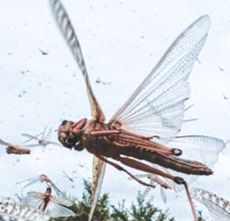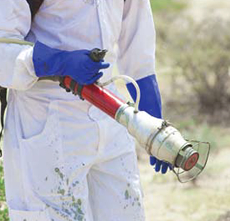Fighting the Swarm: An Interview with Dr. Roger Price on Protecting Agriculture from Desert Locusts
 There is no debate that the desert locust is one of the most destructive migratory pests in the world. Swarms of desert locusts are so massive that they are measured in kilometers, and a single locust can eat its weight in food in a day. This, coupled with locusts’ exponential breeding rates, can lead to unmatched loss of crops and farmland across entire countries, devasting the local communities and threatening food security across the planet.
There is no debate that the desert locust is one of the most destructive migratory pests in the world. Swarms of desert locusts are so massive that they are measured in kilometers, and a single locust can eat its weight in food in a day. This, coupled with locusts’ exponential breeding rates, can lead to unmatched loss of crops and farmland across entire countries, devasting the local communities and threatening food security across the planet.
As of June 2020, much of East Africa was facing a desert locust crisis. The situation is particularly acute in Kenya, Somalia and Ethiopia. To understand the global implications of locust swarms on food security, CropLife International spoke with Dr. Roger Price of the Plant Protection Research Institute in Pretoria, South Africa.
CropLife: Thank you for agreeing to be interviewed, Dr. Price. Can you please tell us what makes locusts so damaging to agriculture and food security?
Dr. Price: It’s the sheer number of insects per swarm, the sheer weight of food that swarms can eat a day, and the unpredictability of their paths—they rise very quickly and in great numbers.
Swarms impact food security because it’s difficult to estimate where the locusts are going to come from, and what crops they are going to damage—they eat a very wide range of crops and that impacts especially rural, resource-poor farming areas in East Africa, hitting them very hard.
CropLife: The World Bank has reported that this year’s outbreak is the biggest outbreak faced by some countries in 70 years. What factors made this year’s outbreak so significant?
Dr. Price: To start, warm ocean weather in the Indian Ocean has caused cyclones to hit very dry areas in the Arabian Peninsula in 2018 and 2019, which was followed up by successful breeding of locusts. So it wasn’t just one breeding episode—successful breeding over a number of seasons has led to this outbreak.
A lot of these areas are war zones, so monitoring capacity in those areas has dropped or collapsed. On top of that, there had been no locusts for quite a few years, so people weren’t actually looking for the locusts. And then the swarms suddenly emerged in January and came into Kenya and Somalia.
COVID-19 has also impacted operations with the lockdown slowing down the delivery of pesticides and spray aircraft allowing some of the swarms to escape to their summer breeding areas.
CropLife: What tools do farmers have available to fight locusts?
Dr. Price: Subsistence farmers don’t have wide access to pesticides or resources to be able to combat the locusts. It’s the situation we’ve been in for the past hundred years—you end up chasing locusts by setting fires or banging drums to chase them away.
 You need an early warning system so that you can at least warn the farming communities that locusts are on their way, so they react to those outbreaks and swarms as quickly as possible with whatever resources they have. So mapping where vulnerable crops are, where locusts are likely to be, wind directions, temperatures, all that sort of stuff can help.
You need an early warning system so that you can at least warn the farming communities that locusts are on their way, so they react to those outbreaks and swarms as quickly as possible with whatever resources they have. So mapping where vulnerable crops are, where locusts are likely to be, wind directions, temperatures, all that sort of stuff can help.
But on their own individual farmers don’t stand a chance when 20 square kilometers of locusts come and land on their farms. When they get out of control, they take a number of years to get back into recession areas, and usually it’s a combination of a vast expense of pesticides and international effort, combined with weather conditions, such as a drought.
CropLife: Can you tell us about the effectiveness of pesticides in controlling locusts?
Dr. Price: The FAO [United Nations Food and Agriculture Organization] only uses pesticides which have been registered and verified by them. The pesticides currently being used have been well-tested and evaluated, and they are efficient. When applied correctly, trials have shown that they can be used at the minimal effective dose.
But we still are using products which a lot of environmentalists are worried about. We’ve tried alternative methods of locust control. I was involved with the metarhizium production and trials—the fungus against locusts—which works in the laboratory and small trials, but it’s not effective when you have to spray it from aircraft. It doesn’t work quickly or effectively enough. I did my whole PhD thesis on evaluating alternative methods, but the bottom line is: if you want to kill locusts effectively and quickly, then you still have to resort to broadspectrum insecticides.
The world is looking for better compounds, more modern compounds—but they’re very expensive, and that is a problem. It’s a balance between economics and environmental concerns and practicalities.
CropLife: Can you speak about biotech and pesticides, and what role they play in fighting pests and farming in Africa in general?
Dr. Price: Commercial agriculture relies more and more on genetically modified crops because in Africa, it’s not easy to grow staple foods without the pest load: farmers all over the place are getting hit hard by the Fall Armyworm; in southern Africa we have the Tuta Absoluta on tomatoes; we’ve got Maize Lethal Necrosis in east Africa – which are probably coming down here to southern Africa very soon; we’ve got Citrus Greening. There are all sorts of new pests that are coming into the equation.
It’s the subsistence farmers that we are most concerned about—they are directly in the firing line of new pests and diseases, and that directly influences household food security and local community food security.
In South Africa we plant GM maize, so our farmers are protected at the moment from Fall Armyworm. But subsistence farmers who plant conventional or traditional maize in the rest of sub Saharan Africa who don’t have access to GMOs or who don’t want to use GMOs are highly susceptible to Fall Armyworm. You have some cases where farmers suffer 80-100% crop losses.
 CropLife: How can countries outside of East Africa best prepare to address locust outbreaks?
CropLife: How can countries outside of East Africa best prepare to address locust outbreaks?
Dr. Price: In the past hundred years, locusts have infested a vast area: from Portugal to Myanmar, from Uzbekistan to Tanzania. It’s very difficult to contain these locusts once they get going. You need concerted efforts from the international community and boosting the local national capacity to survey reports and control locusts. You need to get the farming community involved with early warnings to try and protect crops and determine which crops are vulnerable.
CropLife: With climate change, do you think we’ll be seeing more outbreaks like this regularly going forward?
Dr. Price: Yes, I think so. Locusts and other pests really do well with climate anomalies. Cyclones in Arabia, drought-breaking rains, and widespread flooding, for example, can all lead to pest outbreaks. So I am sure that these insects respond to climate stimulus, and more unpredictable climate is likely to lead to increasing outbreaks of a range of pests.
I think the international community needs to know or understand that for these millions of farmers in Africa and across the world, it doesn’t take much to tip them into a state of financial collapse. Working with these farmers, you realize that millions of people are living on the edge, and more and more of these climate and economic shocks are hitting them hard and making them increasingly vulnerable.
Things like the COVID-19 pandemic and the locust outbreak are very worrying, indeed. The ability to grow food and keep pests away is declining, and most importantly entire communities and livelihoods are at stake as we’re not as resilient as we need to be.
In February 2020, the estimated number of locusts in East Africa was already in the hundreds of billions—by now, the number could be close to 500 times that. Just one square kilometer of locusts can eat as much as 35,000 people. When locust swarms stretch over hundreds of square kilometers—as they do now—they have the potential to impact global food supplies and decimate food security in the communities they infest.
Disclaimer: this interview has been formatted and adapted from its original recording for length and clarity.